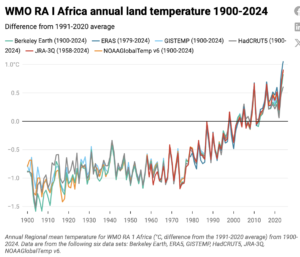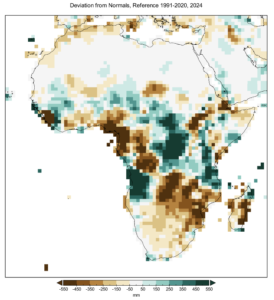According to the World Meteorological Organization’s (WMO) State of the Climate in Africa 2024 report, extreme weather and climate change impacts are causing increased challenges for agriculture and the environment; food, water and energy security; and health and education. However, it also stressed there are opportunities and new tools to meet the challenges.
The WMO states that artificial intelligence (AI), mobile communication tools and advanced weather prediction models are enhancing the accuracy and reach of weather services across Africa. However, further scaling up digital transformation requires greater investment in infrastructure, stronger data-sharing frameworks and more inclusive service delivery, it said.
The report also asserts that a greater sense of urgency is needed to improve early warning systems (EWS) and strengthen climate resilience and adaptation, and urges governments, development partners and the private sector to accelerate climate-smart investment.
The WMO State of the Climate in Africa 2024 report is accompanied by a digital story map and is one in a series of WMO climate reports that seek to inform decision-making for national and regional climate strategies.
Digital transformation
The report also highlights that many countries in Africa are embracing digital transformation to improve weather forecasts and early warnings and this has been identified as a regional priority, with AI bringing new potential to strengthen service delivery.
For example, the Nigeria Meteorological Agency has embraced digital platforms to disseminate vital agricultural advisories and climate information. The Kenya Meteorological Department provides weather forecasts to farmers and fishers through mobile applications and SMS messages. The South African Weather Service has also integrated AI-based forecasting tools and modern radar systems for effective and timely weather predictions.
In a complementary effort in 2024, 18 NMHSs across the continent upgraded their websites and digital communication systems to enhance the reach and impact of their services, products and warnings.
While these efforts represent important steps toward the digital transformation of weather and climate services, much more is needed to integrate these digital technologies into operational systems across the continent, including: increased investment in digital infrastructure and capacity building; stronger data stewardship and sharing frameworks; and improved equitable access and inclusive service.
Key findings
The year 2024 was the warmest or second-warmest year, depending on the dataset, and the past decade has been the warmest on record. Sea-surface temperatures around the continent were at record levels, with particularly rapid warming in the Atlantic Ocean and the Mediterranean Sea. Marine heatwaves affected the largest area since measurements started in 1993, the report states.
“The State of the Climate in Africa report reflects the urgent and escalating realities of climate change across the continent,” said Celeste Saulo, secretary-general of the WMO. “It also reveals a stark pattern of extreme weather events, with some countries grappling with exceptional flooding caused by excessive rainfall and others enduring persistent droughts and water scarcity.
“WMO and its partners are committed to working with members to build resilience and strengthen adaptation efforts in Africa through initiatives like Early Warnings for All. It is my hope that this report will inspire collective action to address increasingly complex challenges and cascading impacts.”
Temperatures

The average surface temperature across Africa in 2024 was approximately 0.86°C above the 1991–2020 long-term average. North Africa recorded the highest temperature (1.28°C above the 1991-2020 average) and this is the sub-region of Africa that is warming fastest. Extreme heat hit many parts of the continent during 2024.
Sea surface temperatures were found to be the highest on record, ahead of 2023. Particularly large increases in sea surface temperatures were observed in the Atlantic Ocean and Mediterranean Sea. Almost the entire ocean area around Africa was affected by marine heatwaves of strong, severe or extreme intensity during 2024, especially the tropical Atlantic. From January to April, nearly 30,000,000km² was affected, which was the largest since the start of monitoring in 1993, although the area decreased later in the year.
Precipitation

According to the report, an El Niño event and positive Indian Ocean Dipole phase, which extended from 2023 into early 2024, played major roles in rainfall patterns.
Southern Africa experienced damaging drought conditions, particularly in Malawi, Zambia and Zimbabwe, which suffered the worst drought in at least two decades. The aggregate cereal yields in southern Africa were 16% below the five-year average, and in the case of Zambia and Zimbabwe 43% and 50%, respectively. Low water levels and low hydropower output from Lake Kariba, Africa’s largest man-made reservoir, caused prolonged power outages and economic disruption.
In East Africa, exceptionally heavy long rains from March to May led to severe flooding in Kenya, Tanzania and Burundi. Rainfall during the October to December season was below average, raising food security concerns. Nigeria, Niger, Chad, Cameroon and the Central African Republic were among the most flooded countries.
North Africa recorded its third consecutive below-average cereal harvest due to low rainfall and extremely high temperatures. Morocco’s output fell 42% below the five-year average after six consecutive years of drought.
Tropical cyclones
For the first time in the satellite era, two tropical cyclones, Hidaya and Ialy, developed in May and moved over the far northwestern part of the basin near Tanzania and Kenya over a region rarely frequented by mature tropical systems.
Tropical Cyclone Chido was the most powerful storm in 90 years to affect Mayotte (France), which forms part of the Comoros archipelago. It then hit Mozambique and Malawi.
In related news, the WMO recently launched its State of the Global Climate 2024 report, detailing the signs of human-induced climate change and the economic and social upheavals from extreme weather in 2024. Click here to read the full story.



